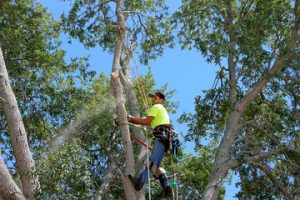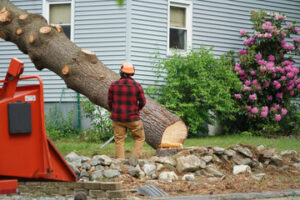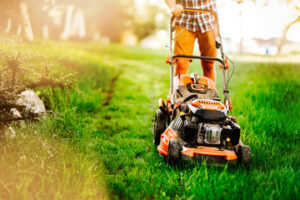Tree service companies provide a variety of services that keep trees healthy and beautiful. They also reduce the risk of property damage and injury. They can remove fallen limbs, clear debris, and prevent storm damage.

When hiring a tree service, it is important to do your research. Ask friends and family about their experiences with local companies. Keep reading to get additional insights on Emergency Tree Service.
Trees are a desirable feature of commercial properties, offering relaxing green space and enhanced curb appeal. However, they can also pose a threat when neglected. Unhealthy trees can fall and cause damage or injury to people, cars, or structures. To prevent this from happening, it is vital to hire a commercial tree services company that can offer regular maintenance. In this way, you can avoid costly repairs and protect your property and community from the risk of injuries and liability.
Tree services can perform a wide range of preventive maintenance tasks, including pruning, trimming, and pest control. They can also identify early signs of disease or structural weakness and recommend interventions before they become serious problems. They can also help you develop a long-term plan for replacing old or damaged trees.
Preventive maintenance services can improve your landscaping and boost the value of your property. By regularly trimming and pruning your trees, you can prevent them from becoming overgrown and encroaching on your home. In addition, you can improve your property’s curb appeal by eliminating dead or dying branches and reducing the amount of debris that accumulates on your property.
An ISA-certified arborist can assess your property and recommend the best preventive maintenance services to meet your needs. They will provide regular inspections to spot potential problems and address them before they cause extensive damage or require expensive intervention. They can also help you manage your trees through cultural, biological, and chemical controls to keep them healthy and in good shape.
Whether you are looking for an ISA-certified arborist to manage your trees or need a tree service to remove a damaged tree, it’s important to choose the right one. When choosing a provider, consider their experience and track record, as well as customer reviews. Also, make sure to ask for quotes before hiring someone to do the job.
Keeping your tree health in top condition is essential to protecting your property and avoiding costly repairs. Regular tree trimming helps trees allocate resources more efficiently, reducing the risk of diseases and fungi. In addition, it reduces the risk of damage to your home or power lines during strong winds. A professional tree service can also perform cabling and bracing to support weaker branches and prevent them from collapsing.
Emergency services
Emergency tree services provide immediate assistance in dangerous situations. They are available round the clock to respond to your calls. They can help you clear trees that have fallen due to storms or are threatening structures. They can also mitigate risks posed by unstable or leaning trees. Additionally, they can trim or remove branches that have become tangled in power lines. Emergency tree services are crucial for the safety of people and property.
Damaged or downed trees can cause serious problems and disrupt daily activities. They can block roads, obstruct driveways and sidewalks, and cause structural damage to buildings or homes. However, these situations can be resolved quickly by hiring a reliable tree service company. A professional tree service will work with your insurance company to file an insurance claim. They will handle the entire process from start to finish, ensuring that all necessary steps are taken.
In addition to removing trees, tree services can also help you restore your landscape after a disaster or natural event. They can perform a risk assessment, clearing debris for functional access, and pruning or removing hazardous branches. They can also install support systems to reduce the chances of a collapsed tree. They can even recommend preventative measures to mitigate future emergencies, such as trimming and pruning.
Emergency situations such as falling trees or a damaged power line can occur at any time. A professional tree service will respond immediately and take the appropriate steps to ensure the safety of your family or employees. They will use caution tape or cones to block off the area, and they will put up signs that alert passersby of potential dangers. They will also ensure that the tree or branches are cleared promptly to avoid any further damage.
A reputable tree service will have years of experience in handling insurance claims for homeowners and businesses. They can help you navigate the often complex process of filing an insurance claim and will make sure that all details are addressed. They will also have a certified tree safety professional on staff to ensure that all staff members follow strict safety guidelines.
Stump grinding
Stumps can look unsightly and are tripping hazards for people walking through your yard. You can hire a professional tree service to grind the stumps and remove the root system, which will make your yard look more attractive. However, the cost of this service varies depending on many factors. Understanding these costs will help you budget effectively for the service.
One of the most important factors is the size and complexity of the stump. Larger stumps require more time and effort to grind, which can increase the price. Stumps with a complex root system are also more expensive than smaller ones. Additionally, the type of tree plays a role in how difficult it is to grind a stump. Softer woods like pine, conifer, cedar, and cypress are easier to grind than hardwoods such as oak, maple, birch, and hickory.
Some professionals charge by the stump, while others have set rates for small, medium, and large stumps. This allows them to provide a better estimate of the total project cost before starting work. The number of stumps also affects the overall cost, as more than one will require more labor and specialized equipment. Moreover, if the stumps are located on challenging terrain, it will take longer to complete the job. This can lead to increased costs, ranging from $50 per hour to a flat fee of up to $200.
Local regulations can also impact the cost of stump grinding services. For instance, some municipalities require a permit before grinding a stump. This is a safety precaution that protects underground utility lines and ensures compliance with environmental standards. In addition, homeowners associations may impose specific guidelines, resulting in additional fees.
Other variables that can influence the cost of stump grinding include debris removal and landscaping costs. The former includes charges for disposing of the stump and its roots, while the latter involves placing soil over the hole created by the grinding process. Lastly, some pros may also offer sodding as a follow-up service, which can add to the overall cost. The costs of these additional services can vary significantly, so it is best to understand them before hiring a stump grinding service.
Tree removal
Tree service companies offer a variety of services that help to improve the health and appearance of trees on property. They can assist with removing dead trees, pruning existing ones, and planting new ones. They can also remove stumps and clear away debris from fallen trees or branches. These professionals are skilled at handling the equipment needed for the job, and they can complete the work quickly and efficiently. They can also take care of other landscaping projects on your property, such as trimming shrubs and hedges.
Trying to take down a tree without the proper training and experience is dangerous. Even small trees can weigh hundreds of pounds, and misjudging their fall could cause damage to property or injury to people. This is why it’s important to contact a professional tree service company, as they have the expertise and equipment necessary to safely take down trees.
A good tree service company will take the time to evaluate a property’s specific needs and develop a comprehensive care plan. They will consider factors such as disease management, growth optimization, and hazard prevention. They can also recommend appropriate fertilization and mulching strategies to keep the trees healthy.
Reputable tree service companies will also provide emergency services when needed. They will respond promptly to storms, heavy winds, and other weather events that cause damage to trees. They can also remove tree debris and restore safety, as well as prune and trim damaged trees to prevent further damage.
When looking for a tree service provider, make sure that they have the proper credentials and licenses to do business in your area. A licensed arborist will follow strict safety protocols and adhere to OSHA guidelines. They will also carry liability insurance, which protects them against any damages or injuries that may occur during the course of their work.
Tree removal is a critical part of any landscape, and it can be a difficult task to do yourself. Many homeowners and businesses find that hiring a tree service is the best way to keep their yards looking beautiful and healthy. By choosing the right provider, you can rest assured that your yard will be in great shape for years to come.

